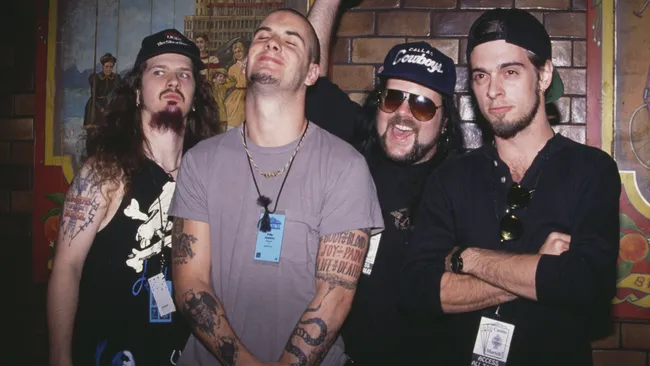
When Pantera entered the studio to record Cowboys from Hell in 1989, they were a band at a crossroads. The spandex and flash of their early glam metal era were fading fast, replaced by a hunger for something heavier, rawer, something that could truly represent who they were becoming. Out of that fire came a new sound, a new identity, and a song that changed the trajectory of heavy metal itself.

“No Pro Tools, no tricks or whistles. We as a band helped change the production of heavy metal records,” Rex Brown, Pantera bassist
That quote from Brown perfectly captures what made Pantera’s transformation so monumental. The band didn’t just play heavier music, they redefined how it sounded. With one groundbreaking track, they turned the studio into a weapon, stripped production down to its bones, and carved a new standard for what “heavy” meant.
The Song That Started It All: “Cowboys From Hell”
It began with a riff. A grinding, groove-laden guitar pattern from Dimebag Darrell that didn’t sound like the speed metal of the ’80s or the sludge of early doom. It grooved. It moved. It hit.
When Dimebag brought that riff to rehearsal, the band instantly knew they’d struck gold. It was the bridge between their past and their future, the song that would become the blueprint for Pantera’s reinvention.
“Cowboys from Hell,” the title track of their 1990 major-label debut, wasn’t just a banger; it was a mission statement. It announced to the world that Pantera was no longer chasing trends, they were creating them. The combination of Dimebag’s sharp, precise tone, Vinnie Paul’s bone-crushing drums, Rex Brown’s gut-level bass, and Phil Anselmo’s raw, unfiltered vocals created something new: groove metal.
A New Era In Metal Production
At a time when most metal albums were drowning in reverb and excess polish, Pantera went the other direction. Working with producer Terry Date, they built their sound around clarity, punch, and power, not studio trickery.
There were no digital corrections, no layered samples, no automated perfection. Just musicians in a room, locking in with each other, capturing aggression in its purest form.
“We didn’t need Pro Tools,” Brown recalled in later interviews. “We had tape, sweat, and instinct. That’s how Cowboys was made, raw and real.”
This approach became the new standard for heavy metal production. Where bands once hid behind gloss, Pantera emphasized feel and tone. Dimebag’s guitar sound, a ferocious blend of crunch and precision, inspired countless imitators and remains one of the most studied tones in metal history.
From Texas Bars To Global Dominance
Before Cowboys from Hell, Pantera were regional heroes in Texas, playing clubs, wearing eyeliner, and chasing the ghosts of glam metal. But once “Cowboys” hit MTV’s Headbangers Ball, everything changed.
Audiences hadn’t heard anything like it. It wasn’t thrash, wasn’t glam, wasn’t classic metal, it was something new. The swagger of southern rock fused with the aggression of metal, delivered with a confidence that bordered on defiance.
The album became the launching pad for a historic run:
Vulgar Display of Power (1992) pushed the sound even further, rawer, meaner, and more socially aware.
Far Beyond Driven (1994) debuted at #1 on the Billboard 200, proving that extreme music could dominate the mainstream.
Pantera had arrived, not as followers, but as leaders.
The Lasting Influence
Pantera didn’t just make heavy music; they made it human. Their songs felt like the sound of a band sweating together in a room, because that’s exactly what it was. In an age now dominated by digital perfection, that honesty feels even more revolutionary.
Their approach to production influenced everyone from Machine Head to Lamb of God, from Slipknot to Gojira. Modern metalcore, groove metal, and even post-thrash all owe a debt to the sonic foundation Pantera built with that one song.
And yet, despite their legendary status, Pantera’s success wasn’t about chasing trends or chasing perfection, it was about staying true to their gut.
“We didn’t want to sound like anybody else,” Dimebag once said. “We just wanted to sound like Pantera.”
Mission Accomplished.
A Legacy Cast In Steel
More than three decades later, “Cowboys from Hell” still sounds fresh, fierce, and alive. It’s the sound of four musicians pushing each other to the brink, no filters, no shortcuts.
Pantera’s legacy isn’t just in their riffs or records; it’s in the very DNA of heavy music today. Every band that cranks up the gain, strips down the production, and lets the music speak for itself is following a trail Pantera blazed.
One song. One riff. One vision.
And from it, a new era of heavy metal was born.
Leave a Reply